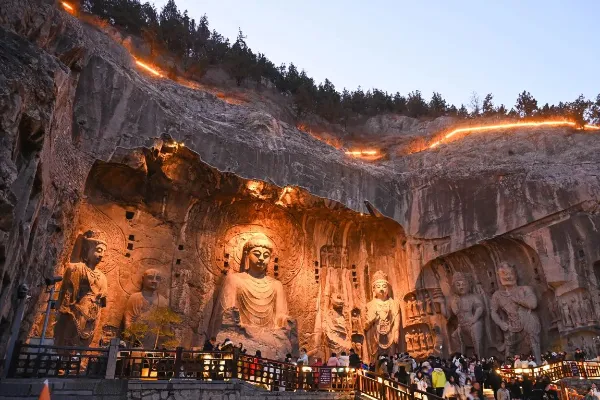
The Longmen Grottoes Scenic Area, located in Luolong District, Luoyang City, Henan Province, is a national 5A-level tourist attraction and UNESCO World Heritage Site. Covering 31.7 square kilometers, its core area includes West Hill Grottoes, East Hill Grottoes, Xiangshan Temple, and Bai Garden. With 2,345 caves and niches, over 100,000 Buddhist statues, and 2,800 inscriptions, it's one of China's greatest stone carving treasure troves, ranking alongside Mogao Caves and Yungang Grottoes as China's top three grottoes. Construction began during Northern Wei Emperor Xiaowen's reign (493 AD), continuing for over 400 years through multiple dynasties.
History and Culture
Carving started around 493 AD when Emperor Xiaowen moved the capital to Luoyang, initially as imperial projects for nobility. Northern Wei works like Guyang Cave and Middle Binyang Cave show Gandharan influences with distinct Central Asian features.
The Tang Dynasty marked the peak, contributing over 60% of all grottoes. Fengxian Temple's Vairocana Buddha niche, built under Empress Wu Zetian, is Longmen's largest (17.14m main statue) and most refined masterpiece, hailed as the "Oriental Mona Lisa."
Inscribed as a World Heritage Site in November 2000, Longmen showcases Buddhism's Sinicization and provides crucial material for studying ancient Chinese politics, economy, religion, and art.
Main Attractions
West Hill Grottoes
The most exquisite section with 2,000+ caves (90% of total). Representative caves include Guyang Cave, Three Binyang Caves, Ten-Thousand-Buddha Cave, Lotus Cave, and Fengxian Temple - the latter housing the magnificent Vairocana Buddha.
East Hill Grottoes
300+ mostly Tang-era caves like Scripture-Reading Temple, Three Drum-Tower Caves, and Thousand-Hand Thousand-Eye Guanyin niche. Smaller but with exceptionally valuable statues in better preservation.
Xiangshan Temple
Buddhist temple founded in Northern Wei, expanded by Empress Wu Zetian who inscribed its name. Current Qing-era buildings house numerous historical steles. Tang poet Bai Juyi lived here in old age, calling himself "Xiangshan Lay Buddhist."
Bai Garden
3-hectare memorial garden for Tang poet Bai Juyi, featuring Letian Hall, Poetry Corridor, and tomb amid serene landscapes, displaying his life stories and literary works.
Featured Experiences
Night Tour
Seasonal night visits (require booking) with dramatic lighting create mystical atmospheres unlike daytime.
Digital Exhibition Center
Uses 3D projection and VR to vividly present Longmen's history and artistry for deeper understanding.
Grotto Art Study
Regular expert-led lectures and study tours for those deeply interested in Buddhist art and history.
Cuisine
Luoyang Water Banquet
Traditional 24-course feast (simplified versions available nearby) named for its soup-based dishes, featuring balanced sweet-sour-spicy flavors.
Non-Turning Soup
Local specialty with mung bean cakes, vermicelli and mushrooms in broth - named because cakes don't flip when cooked. A tasty energy booster.
Peony Silver-Thread Pastry
Traditional peony-shaped pastry with crispy shell and sweet filling, sold in nearby shops as ideal souvenirs.
Ticket Information
Full pass 90 yuan (all main sites); Night tour 120 yuan (seasonal). Half-price for seniors over 60/students, free under 1.4m. Bilingual guided tours available by booking.
Tour Route
Recommended one-day route: North Gate → West Hill (focus on Fengxian Temple, Binyang Caves, Ten-Thousand-Buddha Cave) → Longmen Bridge → East Hill → Xiangshan Temple → Bai Garden → South Gate (4-5 hours). Add Digital Center if time permits.
Transportation
- Driving: ~30mins from downtown via Longmen Avenue (parking available)
- Bus: Routes 53, 60, 81 etc. directly to site
- Train: Luoyang Longmen Station (~5km away)
- Airport: Luoyang Beijiao Airport (~15km)
Must-Visit Attractions
- Fengxian Temple Vairocana: Longmen's iconic Tang masterpiece
- Binyang Caves: Study Northern Wei carving styles
- Ten-Thousand-Buddha Cave: Marvel at 15,000+ exquisite small statues
- Xiangshan Temple: Experience Bai Juyi's Buddhist retreat
- Bai Garden: Explore the Poet King's final resting place
Tour Suggestions
- Best seasons: April-May (peony season) & September-October
- Wear comfortable shoes for extensive walking
- Research grotto culture beforehand for richer experience
- Don't touch carvings to protect relics
- Consider shuttle carts (extra fee) for large site
Precautions
- No flash photography in grotto areas
- Don't climb on carvings or steles
- Secure belongings in crowds
- Bring rain gear for changeable mountain weather
- Maintain quiet in Buddhist sites